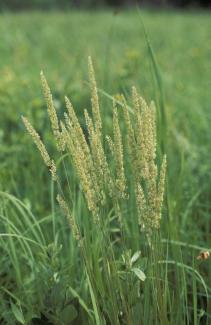Body
that is native to Missouri.
Jim Rathert
Cool-season grasses grow best in cooler temperatures. They start growing early in the spring when soil temperatures reach 40 F. Their growth slows or even goes dormant during summer when soil temperatures reach 78 F. As soils cool down during late summer or early fall, these grasses will start growing again until they go dormant during the cold winter months.
Cool-season grasses include native species like wild ryes and Junegrass and nonnatives like timothy, orchard grass, Kentucky bluegrass, redtop, smooth brome grass, and tall fescue.
Benefits of Cool-Season Grasses:
- They are easy to establish.
- They can withstand heavier grazing.
- They respond well to fertilizer.
Disadvantages:
- They grow poorly during summer, offering less nutrition and forage for livestock during those months.
- They do not fare well during drought.
- When used for hay, cool-season grasses are cut in the spring before ground-nesting wildlife have a chance to raise their young.
- Many of these grass species are sod-forming and grow too thick for quail chicks and other small animals to walk through.






















